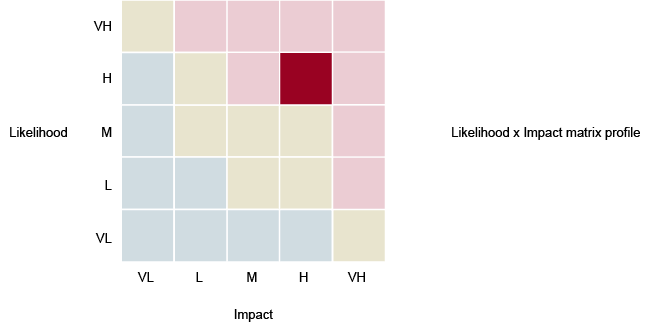Risk Identification
Choosing how to identify risks is unique to each business and is a combination of many factors. A gold mining company is going to be heavily impacted by the market price of gold as certain sites may be cease to be profitable when the gold price drops. Insurance companies are heavily impacted by unforeseen risks like natural disasters, as they may have a sudden unexpected demand for pay-outs. Government departments and organizations have to bear the risk of policy changes that can suddenly alter their finances. Whatever the type of organization, there are implied risks that need to be regularly monitored.
StrategyBlocks keeps the creation and maintenance of risks simple. Users are provided with a sortable, grouped table displaying all the risks they can see, specifically showing the title, sponsor, and status of each one.
Risk Profile
As you identify your risks, you need to assign them two properties, impact and likelihood, in order to assess the magnitude. Both numbers are within in a range of either 1-5 (or 1-3 as defined in your company settings), and their product determines the overall magnitude of the risk.

The magnitude as a product is displayed in the matrix as a colour (green, yellow, red) denoting the relative severity of the risk. StrategyBlocks allows you to customize most aspects of this matrix depending on your company’s preference, including consequences and definition text for each cell which helps to more fully describe the what the magnitude means to you.
Risk and Strategic Management
All strategies have inherent risks, so when you’re building your strategy map, you need to take those factors into account. Triggered risks can have very concrete impacts on your strategic goals, in some cases making it impossible to implement. On the other hand, failed strategies can also cause some risks to trigger.
StrategyBlocks has the concept of strategic health which can both drive risks as well as be impacted by it. Each risk can attach driver blocks that cause the risk to become warning or triggered if the health of that block reaches a certain level. In other words, the failure of a particular strategic initiative can send warnings to the people involved in a particular risk, allowing them to react to the problems before they get out of control.
Because risks also affect strategies, if you attach a risk to a block, it contributes negatively to the health of that block when it is in the warning/triggered states. The amount of contribution is a factor of the risk’s impact and can fully customized.
StrategyBlocks provides a flow-map which helps in visualizing the relationship between your blocks and risks.




